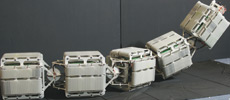

Students at the Swiss Federal Institute of Technology in Zurich have developed a multipartite articulated crawling robot. Its name is Traloc, short for ‘track’ and ‘localisation’. It utilises the concept of a tractor crawler’s track and the aim is the localisation and detection of buried and trapped persons.
Trapped victims can be buried under metres of debris. Localisation and rescue can be a high risk and time critical endeavour. Vibration free, rapid, precise localisation of a victim is crucial for an effective rescue because the probability of survival decreases rapidly over time. The Traloc is designed to explore hard to reach, unstable terrain, to detect signs of life and to perform precise detection and localisation tasks.
Traloc is a modular system with five autonomously propelled, self-contained base elements. Each features a central drive system that propels tracks on all four long sides to guarantee forward motion, regardless of the spatial orientation. Two base elements are interconnected by a gimbal-like joint, which allows free movement in both horizontal and vertical directions. The controls concept consists of a microcontroller for each base element. It manages propulsion and deflection of the corresponding base element, as well as communication with the other microcontrollers in the system. To provide even higher capabilities, the modular design allows the Traloc’s extension with additional base elements.
Cuboidal structures
The foundation stone of the Traloc is a set of self-supporting, cuboidal lightweight structures of about 200 mm side length. They are constructed as self-contained modules and provide space for the drives for the tracks and the joint, associated electronics, sensors, and interfaces. The elements are equipped with a pair of tracks on each side which are simultaneously driven by the central drive system. At their front faces, they feature a freely movable, motorised gimbal joint.
Main drive
The track pairs along the sides of each base element are made of double toothed belts. They are simultaneously driven by a single motor via a central worm reduction gear with four output shafts. This drive principle allows the Traloc to move, regardless of its actual contact faces. The main drives are EC 32 flat IE brushless flat motors with integrated 1-Q speed controller from maxon motor.
Intermediate joint
One of the core mechanical components is an innovative, self-designed joint. The idea is based on an actively powered gimbal joint permitting a deflection angle of more than 45° in both planes. The two degrees of freedom are mechanically decoupled, making it easy to control and very robust against external impacts. Each degree of freedom is actuated by an electric motor via a two stage chain reduction drive. In addition, a contactless rotary angle sensor is used to accurately position the joint. Each axis is driven by a brushless DC motor EC-max 22 with a downstream planetary gearhead with ceramics components GP 32 C, and a 1-Q-EC servo controller DEC Module 50/5.
Control
Traloc features an interface by which rotating angles of the individual intermediate joints and driving speed are transmitted. For drive control, a pioneering self designed Snake Controller was developed. The operator holds a miniaturised model of the Traloc. The desired changes in shape can be determined by adjusting or moulding the individual limbs of the Snake Controller against each other. The driving speed is preset with a slider control. The miniature Traloc’s deviations are then flattened and sent as parameters to the corresponding controllers of the base elements, thus recreating the form and position of the Snake Controller. The control parameters are transmitted via trailing cable, which also hosts lines for energy supply and for data transmission of the robot’s onboard environment sensing instrumentation.
Sensors
The camera mounted up-front on the first base element can move in all axes. An inertial measuring system is located in the middle base element. It monitors the Traloc’s spatial orientation and transmits the data on location, position and geographic orientation to an external CPU. The information is then used to determine the position of pinpointed victims as well as for calculation of the Traloc’s safe returning path.
For more information contact Hans Burri, DNH Tradeserve, +27 (0)11 468 2722, [email protected], www.dnhtrade.co.za
| Tel: | +27 11 468 2722/4127 |
| Fax: | 086 509 6714 |
| Email: | [email protected] |
| www: | www.dnhtrade.co.za |
| Articles: | More information and articles about DNH Technologies |
© Technews Publishing (Pty) Ltd | All Rights Reserved